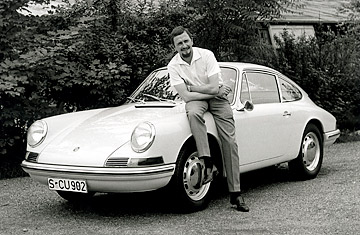
Ferdinand Alexander Porsche leans on a Type 901 Porsche in 1963.

This post is in partnership with Worldcrunch, a new global-news site that translates stories of note in foreign languages into English. The article below was originally published in Die Welt.
(BERLIN) — Nobody outside his family had seen or spoken to him in a long time, ever since he withdrew from the Porsche board seven years ago. Word had it then that Ferdinand Alexander Porsche was a very sick man, although neither his family nor the firm made any details public. On Thursday, April 5, Porsche died at the age of 76. He will be one of the rare car designers to live on through his work.
F.A. Porsche, as those who worked with him called him, or Butzi, to his family, designed the Porsche 911 and created a lasting form that since 1963 has become an icon around the world, like the VW Beetle or the Coca Cola bottle.
The seventh generation of the Nine Eleven is now on the market, but its basic technical and visual concepts remain the same — including what Michael Mauer, Porsche's present head of design, calls the "incomparable" flyline roof. With that and the headlights fitted into front wings flanking a low hood, Porsche had developed the design DNA of the whole brand.
To Porsche — who was kicked out of design school after two semesters — form followed function. "He took that Bauhaus concept and developed it," says Jürgen Gessler, who heads Porsche Design GmbH. Gessler says that the designer believed that "if you think about the function long enough, the design happens all by itself." Because the engine of the Nine Eleven is mounted in the back, for example, no need for a lot of volume at the front of the car.
That the principle carried over into the design of the Panamera limousine (2009) and the Cayenne 4 x 4 (2002) — both of which have front-mounted engines — speaks for just how strong the idea was.
In the 1960s, along with the 911, he designed all the brand's other sports and racing cars himself, including the Formula 1 Type 804 and the 904 Carrera GTS.
Second Life
In 1972, after the company went public and it was agreed that family members would no longer be involved in its day-to-day operations, Porsche opened his own design studio.
But F.A. Porsche, who was the grandson of Porsche founder Ferdinand and the son of engineer Ferry Porsche, was never entirely removed from the company: he was a board member and its chairman for three years, and according to Dieter Landenberger, who runs the Porsche company's historical archive, he continued to be interested in the designs: "He was always discussing things with the designers, also about the Cayenne."
But he no longer designed cars himself, turning to smaller items of daily use: glasses, watches, pens. Here too there were some classics. Jürgen Gessler says that Porsche glasses, launched in 1978 and produced to this day, are "the most successful glasses of all time," with eight million pairs sold thus far. "They were the first glasses with interchangeable lenses and color variants; depending on the situation and time of year you could opt for light or dark lenses," he says — again, a case of function first.
The basic principle allowed for that very relaxed quality to Porsche's designs: a Nine Eleven could be loaded up with spoilers if it would help win a race, and that was fine.
But the series models were totally pared down to their basic form, no bling, and they are the most desirable designs of any on four wheels. Forget about the fifth generation of headlights (1997 to 2006) that weren't round but looked instead like runny fried eggs. What F.A. Porsche had to say about those we don't know. What we do know is that the next model went back to the original round shape. It was quite simply better.
Also from Worldcrunch:
Help Wanted: Booming Brazil Opens Its Doors to Foreign Executives
— América Economia
In Italy, Ancient Ruins Paved Over to Build Soccer Field
— La Stampa
Mitt Romney's Message for Europe: 'Not One Cent' of Bailout Cash
— La Stampa
